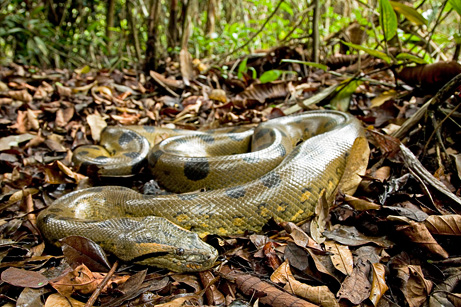The green anaconda (Eunectes murinus) is by far the largest of the anaconda species. It is also one of the few snakes that have the longest lifespans. The anaconda is completely non-venomous boa species and is typically found in South America. Green anacondas are also known as ‘common anaconda’ and ‘water boa’.
Green Anaconda Facts
Anatomy
- Green anaconda grows to a length of 5.21 m (17.1 ft) but male anacondas average 5 m (16.4 ft) while females reach 4.6 m (15.1 ft).
- They have a mean weight of about 30 to 70 kg (66 to 154 lb).
- They are recognized by the olive green skin with prominent dark circles along its length.
- Green anacondas have a small head as compared to its robust body.
- Their eyes are just above the head with the help of which it can see outside the water without even showing itself.
Geographic Range
Green anacondas occur all throughout the tropical rainforests of South America including Venezuela, Brazil, Bolivia, Trinidad islands, Guianas, Peru, Columbia, Paraguay, and Ecuador.

Habitat
They are likely to make homes in wet habitats such as marshes, slow-moving waters, and swamps. Green anacondas prefer water over land. That is not to say that they cannot move on land. They can and they do! It’s just that anacondas intend to strike their prey while remaining itself nearly submerged.
Behavior
- The green anaconda is almost entirely nocturnal. They seem to live around water all year round which is why they are called ‘water boa’.
- They move rather awkwardly on land but in water anacondas are as deadly as any large predator. Inside water, green anacondas reach tremendous speeds.
Feeding Ecology & Diet
- Green anacondas are thought to consume a wide variety of animals such as birds, medium-sized mammals, reptiles, and fish.
- Prominent among mammals are capybaras, tapirs, caimans, and deer.
- Anacondas kill prey animal by rolling it all over and press it hard to suffocate until the prey dies. Moments later, it will swallow the entire animal leaving nothing behind. It’d be as if that animal never walked there.
- Sometimes large female anaconda also eats small male but only sometimes.
Reproductive Biology
- Outside the breeding season, green anacondas remain solitary. The mating occurs from April to May and continues for many months.
- They typically mate in rainy season. All this time, males keep searching females to mate. It is not clear however that how male anacondas are able to track down females. Some believe that male can sense female’s scent while others say that females leave airborne stimulant that are traced by males.
- Like snakes, green anacondas also flick their tongue (in and out) to pick out the chemicals in the air. By doing so, they can also find a female partner.
- Male and female are likely to remain in a mating posture for about 15 – 30 days. A single female may mate with multiple males.
- Mating takes place in water. The gestation period lasts about 180 – 210 days. A female litters 20 – 40 live young but it can give birth to 100 live young at once.
- Baby anacondas are 70 – 80 cm long at birth. They have got many predators because of the small size.
Conservation Status
Not Defined






Leave a Reply